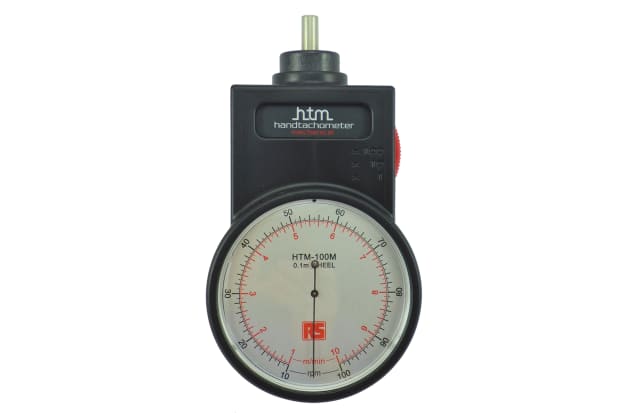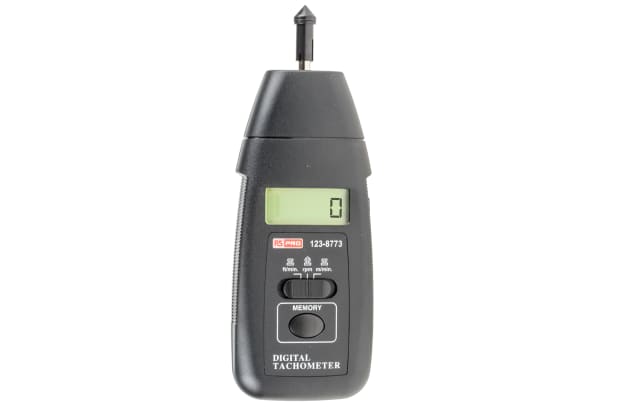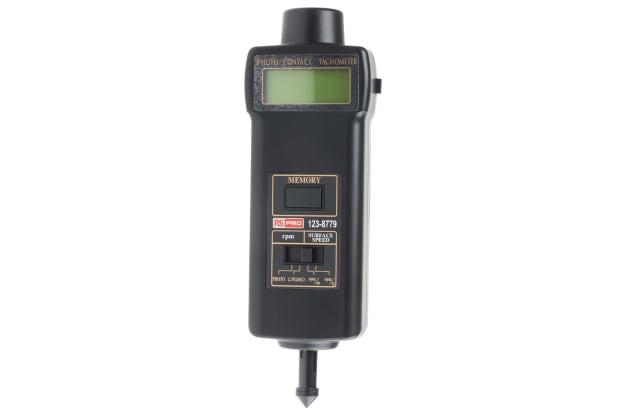- Published 24 Jan 2023
- Last Modified 29 Aug 2023
- 7 min
A Complete Guide to Tachometers
A tachometer is important for many different industries and applications. Discover more in our guide.

What is a Tachometer?
A tachometer is an instrument which measures the rotation speed of a shaft or disk. It is designed to measure the revolutions per minute (RPM) of a moving object.
Tachometers are typically used in motors and other machines and are widely found in the automotive and aviation industries. They are also known as revolution counters, rev counters, RPM gauges, or simply as a ‘tach’.
What are Tachometers Used for?
The purpose of the tachometer is to measure the rotational speed of a machine. For example, within the automotive industry, a tachometer is typically displayed on the dashboard of the car. This informs the driver when to shift gears taking the rotational speed of the shaft into account.
Tachometers can be used to measure a wide variety of objects and performance metrics, including:
- Rotational speed (e.g. wheels or rollers, motors, shafts, fans or turbines)
- Travelling speed (e.g. conveyors)
- Length (e.g. wire, sheet products)
How Do Tachometers Work?
Although there are various types of tachometers, most instruments work in a similar way. They can be categorised in several different ways, but the key types to be aware of in terms of operation are electronic and mechanical tachometers.

How Does an Electronic Tachometer Work?
Most modern tachometers are electronic instruments featuring numerical readings and data storage capabilities. With electronic tachometers, the ignition system triggers a voltage pulse whenever the spark plug fires, at the output of the electromechanical part.
In turn, the electromechanical part corresponds to the average voltage of this series of pulses. It shows the average voltage of the pulse train as directly proportional to the engine speed. The signal is then transmitted to the indicator via a twin screened cable and displayed to the user via an LED or LCD readout.

How Does a Mechanical Tachometer Work?
Mechanical tachometers work by utilising the dependency of centrifugal force on a rotating mass on the rotation speed. This force can compress or stretch mechanical springs.
Resonance tachometers are a subtype of mechanical tachometers. These devices use a set of consecutively-tuned reeds to identify the speed of an engine. These instruments work by determining the machine’s vibration frequency.
Types of Tachometer
There are several main types of tachometers, each best suited to different uses and applications. In addition to electronic and mechanical tachometers, as explained above, the two principal types are contact and non-contact tachometers. These can then be broken down further as detailed in the sections below.

Contact Tachometers
Contact tachometers require contact with a rotating object to measure its RPM. They work by using an optical encoder or a magnetic sensor, depending on the particular model. Direct contact with the shaft or rotating component must be maintained in order to achieve an accurate reading.

Non-Contact Tachometers
Non-contact tachometers can perform measurements without the need for direct contact with the object. They commonly work with lasers or infrared light and are ideal for use with hazardous, hard-to-access, or mobile objects.

Laser Tachometers
Laser tachometers feature a laser on the end of the device which can be pointed at a rotating object to measure RPM via a direct reading function. They are a type of non-contact tachometer and are ideal for use in difficult to access areas, such as tight spaces or working with industrial machinery. Laser tachometers feature varying detecting distances depending on the particular model, but 1-2m is standard.

Optical Tachometers
Optical tachometers include an optical sensor which is used to measure the rotational speed of the wheel, motor, or shaft. They use a laser or beam of light to measure the RPM and are also able to measure any differences in frequency of the reflected light.
How to Use a Digital Tachometer
A digital tachometer is relatively simple and straightforward to use. With a non-contact electronic tachometer, operation can be completed simply by pointing the instrument at the motor or engine. These instruments typically feature a laser on the end of the tachometer for this purpose. Once pointed at the turning object, the device will measure the RPM (revolutions per minute) and display the results for the user.
Various tachometer accessories are also available to assist with installing and working with these devices. Accessories can include measuring wheels, adapters, and fittings, and they are designed to work with tachometers to provide a comprehensive solution.
How to Test a Tachometer
In order to test a rev counter for a vehicle, the tachometer probe must be fitted in a multimeter. The process of using a tachometer in an automotive application is as follows:
- Put the multimeter on the AC setting
- With the engine on, touch the multimeter to the tachometer wire leading to the breaker box
- Enlist the help of another individual to sit in the vehicle and record when the rev counter dial reaches particular points which are key to the calibration process
- The multimeter will simultaneously display accurate readings
- Compare both readings to evaluate the tachometer’s accuracy
How to Wire a Tachometer to a Coil
Installing a tachometer to a coil can be a useful way to monitor performance by gauging engine RPM within a vehicle or automotive environment. The process of wiring a tachometer to a coil is as follows:
- Mount the tachometer in the desired location, ensuring it is easy to read
- Route the three wires (typically red, black, and green) from the rear of the unit under the dashboard
- Use wire strippers to strip approximately 6mm insulation off each wire
- Install a terminal on the red wire and use a crimping tool to secure
- Use a crimping tool to attach a connector to the black wire
- Install it under the dashboard on bare metal
- Install a fuse tap onto a fuse with power when the key is on (for example, the radio fuse)
- Route the final wire through the firewall, beneath the dashboard, and into the engine compartment via an opening with a rubber grommet
- Ensure the wire is fully secured for safety reasons and to protect surrounding components
- Locate the negative side of the engine ignition coil and attach the wire
- Use a crimping tool to attach a connector to the coil terminal and tighten with a wrench
- Test the newly installed tachometer by starting the vehicle
As this task involves electrics, it is highly recommended to only carry it out if you are qualified and fully knowledgeable about the process. An expert auto electrician will be able to install a tachometer to a coil within a vehicle on your behalf if necessary.
Tachometer Wiring Diagram
The below diagram shows how to wire a tachometer in an automotive application. It can be used in conjunction with the steps outlined above to provide a visual representation of how to wire a tachometer. Please note that wiring colour codes may vary from those shown in the diagram, depending on the make and model of tachometer you are using. As a result, you should reference the manufacturer’s guidelines for your particular device before installation.

Tachometer Applications
Tachometers can be used in a wide variety of applications across a range of industries and environments. Typical applications could include:
- Vehicles and automotive
- Boats and marine vehicles
- Machinery and mechanical systems
- Research and development
- Laboratories, test and measurement
- Maintenance and routine industrial operations
Cars
Tachometers used within vehicles allow the driver to choose the most suitable gear and throttle settings for the current conditions. They are beneficial for optimising performance and protecting the engine from overheating, insufficient lubrication, and causing unnecessary wear and tear to components within the system.
Boats
Tachometers can also be used with boats to measure the RPM of the vessel’s engine. They can also be used to monitor engine speed and inform decisions surrounding performance and fuel consumption. Boat tachometers can be used with a range of different boat and engine types, including inboard or outboard motors and diesel engines.